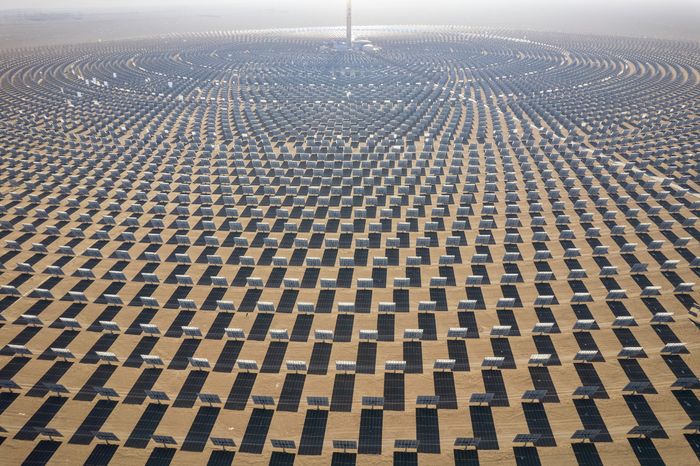The 1.5 °C target might be out of reach, so what comes next?
With recent heatwaves becoming more intense and more frequent, Tom Howarth considers whether we are on track to reach the targets set out by the Paris Climate Agreement

The 2015 Paris Climate Agreement was a historic deal, bringing together almost all the world’s countries around one collective aim: to limit global warming to “well below” 2 °C above pre-industrial levels and strive for 1.5 °C if possible. Since then, 1.5 °C has become the rallying cry for governments and activists alike, with countless scientific models and predictions centring around it. Just six years later, at the COP26 climate summit in Glasgow, the target was described by many as being on life support; now, some scientists are saying it’s time to pull the plug.
The problem isn’t that capping the global temperature rise to 1.5 °C is now impossible, as many climate optimists will hasten to point out, but that the rate at which emissions have been cut so far have made it increasingly implausible that this will happen.
“As things stand, we’re on track for a 3 °C rise by 2100”
According to the latest Intergovernmental Panel on Climate Change (IPCC) report, greenhouse gas emissions must fall 43% by 2030 if we are to stand any chance of achieving the target. To put that into context, in 2020, as the world’s economy ground to a halt in response to the COVID-19 pandemic, global emissions fell by a record 5.4%. To meet the goal, that drop would have to be replicated yearly for the next 8 years. But with emissions jumping straight back to pre-Covid levels by the end of 2021 and further rises expected this year, it seems ever more unlikely to unfold.
Indeed, climate modelling is notoriously difficult, meaning any predictions can be subject to significant error and any exact numbers should be taken with a pinch of salt. Nonetheless, the wealth of evidence pointing towards a >1.5°C world is becoming overwhelming and the speed at which this is becoming our reality is alarming many scientists. Global temperatures are already at 1.1 °C above pre-industrial levels, and according to a recent study by The Met Office, there’s now a 50% chance of it creeping up the remaining 0.4 °C within just five years.
With so much evidence pointing in the same direction, many are beginning to ask what such a world would look like. And, if the goal really is dead in the water, what scenario should we be pursuing instead?
As things stand, we’re on track for a 3 °C rise by 2100 and it’s safe to say this would look and feel dramatically different to the planet that we inhabit now - and not in a good way. The recent heatwaves that we have been enjoying in the UK are likely to become the new normal in such a scenario, but so too are increasingly destructive storms, wildfires, and natural disasters that we’ve come to recognise as the tell-tale signs of our warming planet. With almost half the world’s population already thought to be “highly vulnerable” to the effects of climate change, the human cost of a 3 °C rise is bordering on unimaginable.
But before dystopian images of a post climate apocalypse world begin flooding your nightmares, it’s important to note that this trajectory represents a huge success for the climate fight. It was only a decade ago that we were looking at a 5 °C warming scenario and the fact that 195 countries came to an agreement (at least in principle) is nothing short of a miracle that we’d be foolish to forget. There’s no reason to assume that we won’t continue to chip away at these projections, and with any luck, progress will speed up as new technologies become available and older solutions drop in price.
The other ray of hope is a concept known as “climate overshoot”, which states that although 1.5 °C might be exceeded in the short-term, long-term sequestering of carbon could allow the temperature to stabilise back at a lower level later. As risky as that may be given the potential tipping points that lie ahead and the time required for any overshoot scenario to play out, it does at least provide future generations with some light at the end of the tunnel.
“The rate at which emissions have been cut so far have made it increasingly implausible that this will happen”
It’s clear that when it comes to limiting the effects of climate change, setting targets is important. They provide a set of goalposts that governments can legislate for and allow industries to plan their response. Beyond that, they provide a tangible framework of the complex solutions required to achieve such a seismic shift in the way our world operates. It remains for policy makers to decide whether the goalposts should be moved, and in the meantime, scientists will continue to assess what remains possible. But one thing is certain: if 1.5 °C is breached, every fraction of a degree will count.
 News / CUP announces funding scheme for under-represented academics19 December 2025
News / CUP announces funding scheme for under-represented academics19 December 2025 News / SU reluctantly registers controversial women’s soc18 December 2025
News / SU reluctantly registers controversial women’s soc18 December 2025 News / Cambridge welcomes UK rejoining the Erasmus scheme20 December 2025
News / Cambridge welcomes UK rejoining the Erasmus scheme20 December 2025 Features / Should I stay or should I go? Cambridge students and alumni reflect on how their memories stay with them15 December 2025
Features / Should I stay or should I go? Cambridge students and alumni reflect on how their memories stay with them15 December 2025 Film & TV / Timothée Chalamet and the era-fication of film marketing21 December 2025
Film & TV / Timothée Chalamet and the era-fication of film marketing21 December 2025










